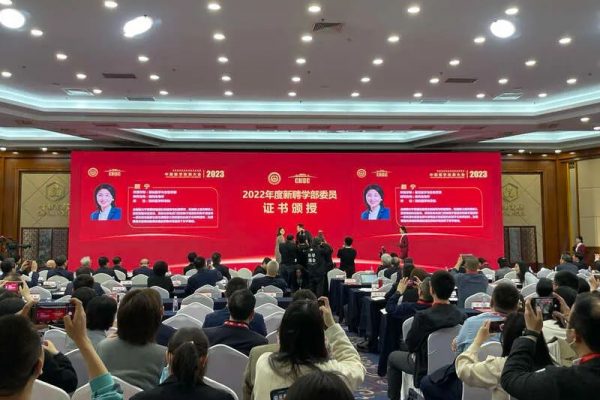Chip发表中国科学院深圳先进技术研究院孙蓉团队最新研究成果:高导热和高阻尼复合凝胶作为芯片散热的热界面材料
FUTURE远见| 2022-06-24
Future|远见
Future|远见future选编
随着新能源和智能联网车辆的发展,过热和不可避免的振动已成为严重威胁芯片(如CPU和GPU)可靠性的两个重要因素。为了消除复杂的振动干扰,我们迫切需要开发兼具高效散热与减震的新一代的热界面材料。然而,材料的导热和阻尼特性通常是相互关联和耦合的。
受麦克斯韦理论和壁虎刚毛粘附机制的启发,本工作研究了一种聚二甲基硅氧烷(PDMS)基复合凝胶,通过在PDMS网络中引入悬挂链,集成了高热导率和显著的阻尼特性。该PDMS/Al复合凝胶可获得对分子弛豫时间的多尺度控制,从而对能量分级耗散进行多级调控。弛豫时间的扩宽和动态相互作用的协同效应使复合凝胶在宽频率(0.01~100 Hz)和温度范围(–50~150 °C)范围内表现优异的阻尼性能(tan δ > 0.3)。类似于壁虎的足掌微毛结构,短的悬挂链结构通过范德华相互作用可改善PDMS和Al填料之间的粗糙界面,而表现高热导率(4.72±0.04 W m⁻¹ K⁻¹)。
本研究证明了该复合凝胶的热界面材料在芯片热管理应用中的散热效率是目前商用TIMs的2.1倍,同时也证实了在剧烈振动(10 Hz振动频率)下运行的芯片仍然表现出高效稳定散热能力。最后,本研究实现了该复合凝胶在黏度和可加工性之间的平衡,完美展现了该PDMS/Al复合凝胶的点胶工艺,在柔性可穿戴设备、智能网联汽车等领域有着巨大潜力应用价值。
本篇文章的研究团队认为该项工作为制备用于柔性电子产品的高导热和高阻尼复合凝胶开辟了一条新的途径。
High Thermal Conductivity and Remarkable Damping Composite Gels as Thermal Interface Materials for Heat Dissipation of Chip
With the development of new energy and intelligent connected vehicles (ICVs), the excessive heat and inevitable operational vibrations have become two serious threats to the reliability of chips (e.g., CPU and GPU). To eliminate complex vibration interference, there is an urgent need to develop the next-generation thermal interface materials (TIMs) that combine efficient heat dissipation along with vibration elimination. However, thermal conductivity and damping properties are usually correlated and coupled each other.
Inspired by Maxwell theory and adhesion mechanism of gecko’s setae, the research team report a type of polydimethylsiloxane (PDMS)-based composite gels incorporating both high thermal conductivity and remarkable damping properties, which is achieved by introducing dangling chains into PDMS network. The PDMS/Al composite gels allow us to gain multi-scale control over molecular relaxation times and thereby multilevel control over hierarchical energy dissipation (HED). The synergistic effect of the broadened relaxation time and the dynamic interaction results in a higher damping composite gels with ultrahigh damping property (tan δ > 0.3) over broad frequency (0.01~100 Hz) and temperature ranges (–50~150 °C). Additionally, the short 「molecular hair」 structures, which act in ways similar to the micro- and nano-scale fibrillar 「hairs」 on gecko’s feet, also improve the rough interfaces between PDMS and Al via van der Waals interaction, resulting in high thermal conductivity (4.72±0.04 W m⁻¹ K⁻¹). Using PDMS-based composite gels as TIMs, the research team demonstrate effective heat dissipation in chip operating under vigorous vibrations.
Using this work as proof-of-concept, the research team believe that PDMS-based composite gels open a new avenue for the fabrication of highly thermal conductive and efficiently damping composite gels for thermal management of flexible electronics in the future.
关于Chip
Chip是全球唯一聚焦芯片类研究的综合性国际期刊,已入选由中国科协、教育部、科技部、中科院等单位联合实施的「中国科技期刊卓越行动计划高起点新刊项目」,为科技部鼓励发表「三类高质量论文」期刊之一。
Chip期刊由上海交通大学与Elsevier集团合作出版,并与多家国内外知名学术组织展开合作,为学术会议提供高质量交流平台。
Chip秉承创刊理念: All About Chip,聚焦芯片,兼容并包,旨在发表与芯片相关的各科研领域尖端突破性成果,助力未来芯片科技发展。迄今为止,Chip已在其编委会汇集了来自13个国家的68名世界知名专家学者,其中包括多名中外院士及IEEE、ACM、Optica等知名国际学会终身会士(Fellow)。
Chip第二期将于2022年7月在爱思唯尔Chip官网以金色开放获取形式(Gold Open Access)发布,欢迎访问阅读文章。
爱思唯尔Chip官网:
https://www.journals.elsevier.com/chip
预印版链接:
https://www.sciencedirect.com/science/article/pii/S2709472322000119?v=s5
Warning: Invalid argument supplied for foreach() in /www/wwwroot/www.futureyuanjian.com/wp-content/themes/future/single-news.php on line 41



